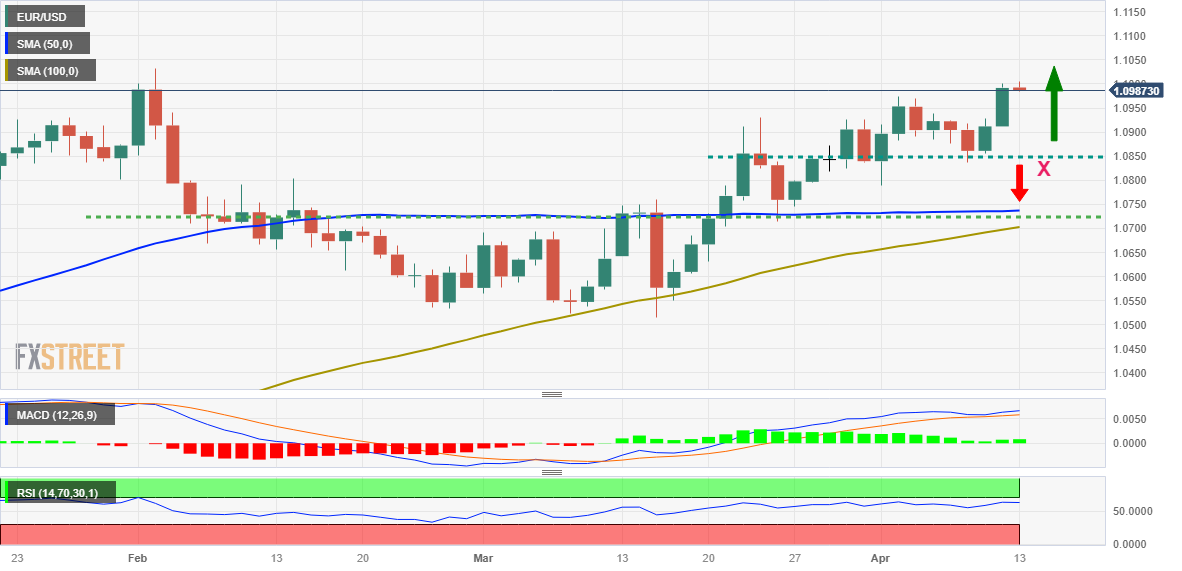- EUR/USD is seen consolidating its recent gains to the highest level since early February.
- Looming recession risks benefit the safe-haven USD and act as a headwind for the major.
- Expectations for an imminent Fed rate hike pause to cap the buck and lend some support.
The EUR/USD pair struggles to capitalize on its gains recorded over the past two days and consolidates in a range around the 1.1000 psychological mark, just below its highest level since early February touched during the Asian session on Thursday. The downside, meanwhile, remains cushioned in the wake of the underlying bearish sentiment surrounding the US Dollar. In fact, the USD Index, which tracks the Greenback against a basket of currencies, languishes near the monthly low amid expectations that the Federal Reserve (Fed) will be done with its monetary tightening after hiking one last time next month. The bets were reaffirmed by the softer-than-expected US consumer inflation figures released on Wednesday.
The US Bureau of Labor Statistics reported that the headline CPI rose by 0.1% in March as compared to the 0.4% recorded in the previous month and the 0.3% anticipated. Furthermore, the yearly rate decelerated from 6% in February to 5.0% during the reported month, while core CPI, which excludes food and energy prices, matched consensus estimates. The data, meanwhile, fueled hopes that disinflation is progressing smoothly and may even accelerate, potentially opening the door for the Fed to cut rates during the second half of the year amid signs of slowing economic growth. Adding to this, the March FOMC meeting minutes showed that several policymakers considered pausing interest rate increases after the failure of two regional banks.
Moreover, San Francisco Fed President Mary Daly also raised the possibility of fewer hikes and said that policy was at a point where rates did not need to be raised at every meeting. This, in turn, led to a fresh leg down in the US Treasury bond yields, which, along with the overnight rally in the US equity markets, seem to undermine the safe-haven buck.
Policymakers, however, were wary of a mild US recession this year in the wake of a banking crisis and as high-interest rates continue to hinder economic growth. The outlook adds to market worries about a deeper global economic downturn and keeps a lid on the optimism in the markets, lending some support to the Greenback and capping gains for the EUR/USD pair, for the time being.
Nevertheless, the aforementioned fundamental backdrop favours bullish traders and should continue to lend some support to the major. Apart from this, growing acceptance for additional rate hikes by the European Central Bank (ECB) suggests that the path of least resistance for the EUR/USD pair is to the upside and any meaningful pullback might still be seen as a buying opportunity. In the absence of any relevant market-moving macro releases from the Eurozone, traders will look to the US economic docket – featuring the Producer Price Index (PPI) and the usual Weekly Initial Jobless Claims data – for some impetus later during the early North American session.
Technical Outlook
From a technical perspective, any subsequent move up might confront some resistance near the 1.1030-1.1035 region, or the YTD peak touched in February. Some follow-through buying will be seen as a fresh trigger for bullish traders and pave the way for a further near-term appreciating move. With oscillators on the daily chart holding in the positive territory and still far from being in the overbought zone, the EUR/USD pair might then aim to reclaim the 1.1100 mark. The momentum could get extended further towards the next relevant hurdle near the 1.1170 horizontal zone.
On the flip side, immediate support is pegged near the 1.0960-1.0950 region and any further decline is more likely to get bought into near the 1.0900 round figure. This should help limit the downside near the 1.0850-1.0830 area, which should now act as a strong base for the EUR/USD pair. That said, a convincing break below might prompt some technical selling and accelerate the corrective slide towards the 1.0800 mark en route to the 50-day Simple Moving Average (SMA) support near the 1.0735 zone and the 100-day SMA, currently around the 1.0700 round figure mark.
